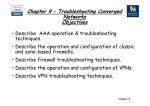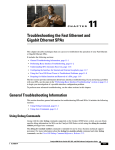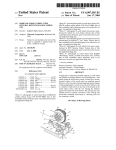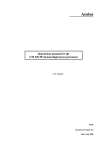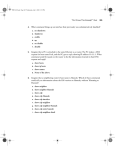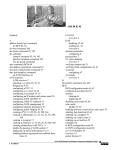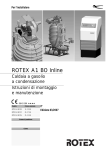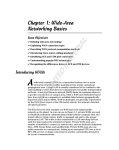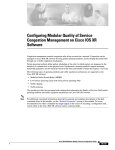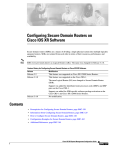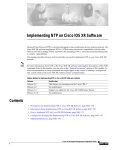Download Cisco Systems SIP-401 User's Manual
Transcript
Configuring Serial Interfaces on Cisco IOS XR
Software
This module describes the serial interfaces on routers supporting Cisco IOS XR software. Before you
configure a serial interface, you must configure the clear channel T3/E3 controller or channelized
T1/E1controller (DS0 channel) that is associated with that interface.
Feature History for Configuring Serial Controller Interfaces
Release
Modification
Release 3.3.0
This feature was introduced on the Cisco XR 12000 Series Router.
Support was added on the Cisco XR 12000 Series Router for the following
hardware:
•
Cisco XR 12000 SIP-401
•
Cisco XR 12000 SIP-501
•
Cisco XR 12000 SIP-601
Support was added on the Cisco XR 12000 Series Router for the following
SPAs:
•
2-Port and 4-Port Channelized T3 Serial SPA
•
2-Port and 4-Port T3/E3 Serial SPA
Contents
•
Prerequisites for Configuring Serial Interfaces, page HC-116
•
Information About Serial Interfaces, page HC-116
•
How to Configure Serial Interfaces, page HC-121
•
Additional References, page HC-124
Cisco IOS XR Interface and Hardware Component Configuration Guide
HC-115
Configuring Serial Interfaces on Cisco IOS XR Software
Prerequisites for Configuring Serial Interfaces
Prerequisites for Configuring Serial Interfaces
Before configuring serial interfaces, be sure that the following tasks and conditions are met:
•
You must be in a user group associated with a task group that includes the proper task IDs for serial
Interface commands. Task IDs for commands are listed in Cisco IOS XR Interface and Hardware
Component Command Reference.
•
Your hardware must support T3/E3 controllers and serial interfaces. The following hardware
supports T3/E3 controllers and serial interfaces in Cisco IOS XR Software Release 3.3:
– 2-Port and 4-Port Clear Channel T3/E3 SPAs
– 2-Port and 4-Port Channelized T3 SPAs
Note
•
The 2-Port and 4-Port Channelized T3 SPAs support T1/E1 controllers and DS0 channels.
You have already configured the clear channel T3/E3 controller or channelized
T3-to-T1/E1controller that is associated with the serial interface you want to configure, as described
in the Configuring Clear Channel T3/E3 Controllers and Channelized T3 Controllers on
Cisco IOS XR Software module earlier in this document.
Information About Serial Interfaces
Serial interfaces are supported on the following Cisco XR 12000 Series Router shared port adapter
(SPA) cards:
•
2-Port and 4-Port Clear Channel T3/E3 SPAs
•
2-Port and 4-Port Channelized T3 SPAs
Note
The 2-Port and 4-Port Channelized T3 SPAs can run in clear channel mode, or they can be
channelized into 28 T1 or 21 E1 controllers.
T3/E3 serial interfaces are automatically created on clear channel T3/E3 controllers. On channelized
T3-to-T1/E1 controllers, serial interfaces are automatically created when users configure individual DS0
channel groups the T1/E1 controllers.
To configure serial interfaces, you must understand the following concepts:
•
High Level Over-View: Serial Interface Configuration on Clear-Channel SPAs, page HC-117
•
High Level Over-View: Serial Interface Configuration on Channelized SPAs, page HC-118
•
Default Settings for Serial Interface Configurations, page HC-119
•
Serial Interface Naming Notation, page HC-119
•
Cisco IOS XR PPP Encapsulation, page HC-120
•
Cisco IOS XR HDLC Encapsulation, page HC-120
•
Keepalive Timer, page HC-120
Cisco IOS XR Interface and Hardware Component Configuration Guide
HC-116
Configuring Serial Interfaces on Cisco IOS XR Software
Information About Serial Interfaces
High Level Over-View: Serial Interface Configuration on Clear-Channel SPAs
Table 10 provides a high-level overview of the tasks required to configure a T3 serial interface on a
2-Port and 4-Port Clear Channel T3/E3 SPA.
Table 10
Overview: Configuring a T3 Serial Interface on a Clear Channel SPA
Step
Task
Module
Section
1.
“Configuring Clear Channel T3/E3
Use the hw-module subslot
command to set serial mode for the Controllers and Channelized T3
Controllers on Cisco IOS XR
SPA to be T3, if necessary.
Software”
Note
By default, the 2-Port and
4-Port Clear Channel
T3/E3 SPA is set to run in
T3 mode.
“Setting the Card Type for the Clear
Channel SPAs”
2.
Configure the T3 controller
“Setting the Card Type for the Clear
Channel SPAs”
3.
Configure the serial interface that is “Configuring Serial Interfaces on
associated with the T3 controller
Cisco IOS XR Software”
you configured in Step 2.
“Configuring Clear Channel T3/E3
Controllers and Channelized T3
Controllers on Cisco IOS XR
Software”
“Configuring the Serial Interfaces”
Table 11 provides a high-level overview of the tasks required to configure an E3 serial interface on a
2-Port and 4-Port Clear Channel T3/E3 SPA.
Table 11
Overview: Configuring an E3 Serial Interface on a Clear Channel SPA
Step
Task
Module
Section
1.
Use the hw-module subslot
Configuring Clear Channel T3/E3
Setting the Card Type for the Clear
command to set serial mode for the Controllers and Channelized T3
Channel SPAs
SPA to be E3.
Controllers on Cisco IOS XR Software
2.
Configure the E3 controller
3.
Configure the serial interface that is Configuring Serial Interfaces on
associated with the E3 controller
Cisco IOS XR Software
you configured in Step 2.
Configuring Clear Channel T3/E3
Setting the Card Type for the Clear
Controllers and Channelized T3
Channel SPAs
Controllers on Cisco IOS XR Software
Configuring the Serial Interfaces
Cisco IOS XR Interface and Hardware Component Configuration Guide
HC-117
Configuring Serial Interfaces on Cisco IOS XR Software
Information About Serial Interfaces
High Level Over-View: Serial Interface Configuration on Channelized SPAs
Table 12 provides a high-level overview of the tasks required to configure a T1 serial interface on the
2-Port and 4-Port Channelized T3 SPA.
Table 12
Overview: Configuring a Serial Interface on a T1 DS0 Channel
Step
Task
Module
1.
“Configuring Clear Channel
Configure the T3 controller
parameters and set the SPA mode to T3/E3 Controllers and
Channelized T3 Controllers on
be T3.
Cisco IOS XR Software”
28 T1 controllers are automatically
created.
“Configuring a Channelized T3-to-T1
Controller”
2.
Create and configure DS0 channel
groups on the T1 controllers you
created in Step 1.
“Configuring a Channelized T3-to-T1
Controller”
3.
Configure the Serial interfaces that “Configuring Serial Interfaces on
are associated channel groups you Cisco IOS XR Software”
created in Step 2.
“Configuring Clear Channel
T3/E3 Controllers and
Channelized T3 Controllers on
Cisco IOS XR Software”
Section
“Configuring the Serial Interfaces”
Table 13 provides a high-level overview of the tasks required to configure an E1 serial interface on the
2-Port and 4-Port Channelized T3 SPA.
Table 13
Overview: Configuring a Serial Interface on an E1 DS0 Channel
Step
Task
Module
1.
Configuring Clear Channel T3/E3 Configuring a Channelized T3-to-T1
Configure the T3 controller
Controller
parameters and set the SPA mode to Controllers and Channelized T3
Controllers on Cisco IOS XR
be E3.
Software
21 E1 controllers are automatically
created.
2.
Create and configure DS0 channel
groups on the E1 controllers you
created in Step 1.
3.
Configure the Serial interfaces that Configuring Serial Interfaces on
are associated channel groups you Cisco IOS XR Software
created in Step 2.
Configuring Clear Channel T3/E3 Configuring a Channelized T3-to-E1
Controller
Controllers and Channelized T3
Controllers on Cisco IOS XR
Software
Cisco IOS XR Interface and Hardware Component Configuration Guide
HC-118
Section
Configuring the Serial Interfaces
Configuring Serial Interfaces on Cisco IOS XR Software
Information About Serial Interfaces
Default Settings for Serial Interface Configurations
When an interface is enabled on a T3/E3 SPA, and no additional configuration commands are applied,
the default interface settings shown in Table 14 are present. These default settings can be changed by
configuration. Default settings do not appear in the output of the show running-config command.
Table 14
Serial Interface Default Settings
Parameter
Configuration File Entry
Default Settings
Keepalive
keepalive [disable]
no keepalive
keepalive 10 seconds
Encapsulation
encapsulation [hdlc | ppp]
hdlc
Maximum transmission unit (MTU)
mtu bytes
4474 bytes
Cyclic redundancy check (CRC)
crc [16 | 32]
32
Data stream inversion on a serial
interface
invert
Data stream is not inverted
Payload scrambling (encryption)
scramble
Scrambling is disabled.
Number of High-Level Data Link
Control (HDLC) flag sequences to be
inserted between the packets
transmit-delay
Default is 0 (disabled).
Serial Interface Naming Notation
The naming notation for serial interfaces on a clear channel SPA is rack/slot/module/port, as shown in
the following example:
interface serial 0/0/1/2
The naming notation for T1, E1, and DS0 interfaces on a channelized SPA is
rack/slot/module/port/t1-num:channel-group-number, as shown in the following example:
interface serial 0/0/1/2/4:3.
Note
A slash between values is required as part of the notation.
The naming notation syntax for serial interfaces is as follows:
•
rack: Chassis number of the rack.
•
slot: Physical slot number of the modular services card or line card.
•
module: Module number. Shared port adapters (SPAs) are referenced by their subslot number.
•
port: Physical port number of the T3 controller.
Cisco IOS XR Interface and Hardware Component Configuration Guide
HC-119
Configuring Serial Interfaces on Cisco IOS XR Software
Information About Serial Interfaces
•
t1-num: T1 or E1 channel number. T1 channels range from 0 to 23; E1 channels range from 0 to 30.
•
channel-group-number: Time slot number. T1 time slots range from 1 to 24; E1 time slots range
from 1 to 31. The channel-group-number is preceded by a colon and not a slash.
Use the question mark (?) online help function following the serial keyword to view a list of all valid
interface choices.
Cisco IOS XR PPP Encapsulation
PPP is a standard protocol used to send data over synchronous serial links. PPP also provides a link
control protocol (LCP) for negotiating properties of the link. LCP uses echo requests and responses to
monitor the continuing availability of the link.
PPP provides Network Control Protocols (NCPs) for negotiating properties of data protocols that will
run on the link:
Note
•
IP Control Protocol (IPCP) to negotiate IP properties
•
Multiprotocol Label Switching control processor (MPLSCP) to negotiate MPLS properties
•
Cisco Discovery Protocol control processor (CDPCP) to negotiate CDP properties
•
IPv6CP to negotiate IP Version 6 (IPv6) properties
•
Open Systems Interconnection control processor (OSICP) to negotiate OSI properties
The default encapsulation type for the serial line card configurations is Cisco HDLC. To change the
encapsulation type to be PPP, you must use the encapsulation ppp command in interface configuration
mode for the serial interface.
Cisco IOS XR HDLC Encapsulation
Cisco High-Level Data Link Controller (HDLC) is Cisco’s proprietary protocol for sending data over
synchronous serial links using HDLC. Cisco HDLC also provides a simple control protocol called Serial
Line Address Resolution Protocol (SLARP) to maintain serial link keepalives. HDLC is the default
encapsulation for serial interfaces under Cisco IOS XR software.
Keepalive Timer
The HDLC usage of the keepalive timer also applies to PPP encapsulation to control how often
ECHOREQ (echo request) packets are sent out.
Use the keepalive command in interface configuration mode to set how frequently LCP should send out
ECHOREQ packets to its peer. To restore the system to the default keepalive interval of 10 seconds, use
the keepalive command with no argument. To disable keepalives, use the no keepalive or keepalive
disable command. For both PPP and Cisco HDLC, a keepalive of 0 disables keepalives and is reported
in the show running-config command output as keepalive disable.
When LCP is running on the peer and receives an ECHOREQ packet, it should respond with an echo
reply (ECHOREP) packet, regardless of whether keepalives are enabled on the peer.
Cisco IOS XR Interface and Hardware Component Configuration Guide
HC-120
Configuring Serial Interfaces on Cisco IOS XR Software
How to Configure Serial Interfaces
Keepalives are independent between the two peers. One peer end can have keepalives enabled; the other
end can have them disabled. Even if keepalives are disabled locally, LCP still responds with ECHOREP
packets to the ECHOREQ packets it receives. Similarly, LCP also works if the period of keepalives at
each end is different.
When the interface has PPP encapsulation, if LCP sends three ECHOREQ packets without an
ECHOREP being received then it declares the link down and initiates full LCP negotiation again. If the
interface has HDLC encapsulation, the number of resends is only three before the link is taken down.
Only when LCP negotiation is complete (for example, when LCP is Open) are ECHOREQ packets sent
out.
How to Configure Serial Interfaces
After you have configured a channelized or clear channel T3/E3 controller, as described in the
Configuring Clear Channel T3/E3 Controllers and Channelized T3 Controllers on Cisco IOS XR
Software module earlier in this document, you can configure the Serial interfaces associated with that
controller. The following task describes how to configure a serial interface.
•
Configuring the Serial Interfaces, page HC-121
Configuring the Serial Interfaces
Before you can use a serial interface, you must configure the IP address and bring the interface to the up
state, as described in the steps that follow.
Note
All global commands are supported on serial interfaces. Only commands specific to serial interfaces are
described in this section. For more information about global interface commands, refer to the Global
Interface Commands on Cisco IOS XR Software module in Cisco IOS XR Interface and Hardware
Component Command Reference.
SUMMARY STEPS
1.
configure
2.
interface serial instance
3.
ipv4 address ip-address
4.
encapsulation [hdlc | ppp]
5.
keepalive {seconds | disable}
6.
serial
7.
crc length
8.
invert
9.
scramble
10. transmit-delay hdlc-flags
11. exit
12. no shutdown
Cisco IOS XR Interface and Hardware Component Configuration Guide
HC-121
Configuring Serial Interfaces on Cisco IOS XR Software
How to Configure Serial Interfaces
13. end
or
commit
14. show interfaces serial instance
DETAILED STEPS
Step 1
Command or Action
Purpose
configure
Enters global configuration mode.
Example:
RP/0/0/CPU0:router# configure
Step 2
interface serial instance
Example:
RP/0/0/CPU0:router(config)# interface serial
0/1/0/0/10:15
Step 3
ipv4 address ip-address
Specifies the serial interface name and enters interface
configuration mode. Naming notation for T3/E3 interfaces
is rack/slot/module/port and for T1/E1/DS0 interfaces is
rack/slot/module/port/t1-num:channel-group-number.
Assigns an IP address and subnet mask to the interface.
Example:
RP/0/0/CPU0:router(config-if)# ipv4 address
10.1.2.1 255.255.255.224
Step 4
encapsulation [hdlc | ppp]
(Optional) Configures the interface encapsulation
parameters and details such as HDLC or PPP.
Example:
Note
The default encapsulation is hdlc.
RP/0/0/CPU0:router(config-if)# encapsulation
hdlc
Step 5
keepalive {seconds | disable}
(Optional) Configures the HDLC keepalive value.
Note
Example:
The default value for the keepalive timer is 10
seconds.
RP/0/R0/CPU0:router(config-if)# keepalive 10
Step 6
serial
(Optional) Enters serial submode to configure the serial
parameters.
Example:
RP/0/0/CPU0:router(config-if)# serial
RP/0/0/CPU0:ios(config-if-serial)#
Step 7
crc length
(Optional) Specifies the length of the cyclic redundancy
check (CRC) on the interface.
Example:
Note
The default is CRC length is 16.
RP/0/0/CPU0:ios(config-if-serial)# crc 32
Step 8
invert
(Optional) Inverts the data stream.
Example:
RP/0/0/CPU0:ios(config-if-serial)# inverts
Cisco IOS XR Interface and Hardware Component Configuration Guide
HC-122
Configuring Serial Interfaces on Cisco IOS XR Software
How to Configure Serial Interfaces
Step 9
Command or Action
Purpose
scramble
(Optional) Enables payload scrambling on the interface.
Note
Payload scrambling is disabled on the interface.
Example:
RP/0/0/CPU0:ios(config-if-serial)# scramble
Step 10
transmit-delay hdlc-flags
(Optional) Specifies a transmit delay on the interface.
Values can be from 0 to 128.
Example:
Note
RP/0/0/CPU0:ios(config-if-serial)#
transmit-delay 10
Step 11
Transmit delay is disabled by default (the transmit
delay is set to 0).
Exits serial configuration mode.
exit
Example:
RP/0/0/CPU0:router(config-if-serial)# exit
RP/0/0/CPU0:router(config-if)#
Step 12
no shutdown
(Optional) Enables the serial interface. Use this command if
the interface was shut down.
Example:
Note
RP/0/0/CPU0:router(config-if)# no shutdown
Step 13
Serial interfaces are enabled by default. However, if
the card or router is reset and the serial interface is
not configured, then it comes up in the shutdown
state.
Saves configuration changes.
end
or
•
commit
When you issue the end command, the system prompts
you to commit changes:
Uncommitted changes found, commit them before
exiting(yes/no/cancel)? [cancel]:
Example:
RP/0/0/CPU0:router(config)# end
– Entering yes saves configuration changes to the
or
running configuration file, exits the configuration
session, and returns the router to EXEC mode.
RP/0/0/CPU0:router(config)# commit
– Entering no exits the configuration session and
returns the router to EXEC mode without
committing the configuration changes.
– Entering cancel leaves the router in the current
configuration session without exiting or
committing the configuration changes.
•
Step 14
Use the commit command to save the configuration
changes to the running configuration file and remain
within the configuration session.
Displays information about the interface.
show interfaces serial instance
Example:
RP/0/0/CPU0:router# show interfaces serial
0/0/3/0/5:20
Cisco IOS XR Interface and Hardware Component Configuration Guide
HC-123
Configuring Serial Interfaces on Cisco IOS XR Software
Configuration Examples for Serial Interfaces
Configuration Examples for Serial Interfaces
The following example shows how to configure a basic serial interface:
RP/0/0/CPU0:Router#config
RP/0/0/CPU0:Router(config)# interface Serial0/3/0/0/0:0
RP/0/0/CPU0:Router(config-if)# ipv4 address 192.0.2.2 255.255.255.252
RP/0/0/CPU0:Router(config-if)# serial
RP/0/0/CPU0:Router(config-if-serial)# crc 16
RP/0/0/CPU0:Router(config-if-serial)# invert
RP/0/0/CPU0:Router(config-if-serial)# scramble
RP/0/0/CPU0:Router(config-if-serial)# transmit-delay 3
RP/0/0/CPU0:Router(config-if-serial)# commit
Following is sample output from the show interfaces serial command:
RP/0/0/CPU0:Router# show interfaces serial 0/0/3/0/5:23
Serial0/0/3/0/5:23 is down, line protocol is down
Hardware is Serial network interface(s)
Internet address is Unknown
MTU 1504 bytes, BW 64 Kbit
reliability 143/255, txload 1/255, rxload 1/255
Encapsulation HDLC, crc 16, loopback not set, keepalive set (10 sec)
Last clearing of "show interface" counters 18:11:15
5 minute input rate 0 bits/sec, 0 packets/sec
5 minute output rate 0 bits/sec, 0 packets/sec
2764 packets input, 2816 bytes, 3046 total input drops
0 drops for unrecognized upper-level protocol
Received 0 broadcast packets, 0 multicast packets
0 runts, 0 giants, 0 throttles, 0 parity
3046 input errors, 1 CRC, 0 frame, 0 overrun, 2764 ignored, 281 abort
2764 packets output, 60804 bytes, 0 total output drops
Output 0 broadcast packets, 0 multicast packets
0 output errors, 0 underruns, 0 applique, 0 resets
0 output buffer failures, 0 output buffers swapped out
0 carrier transitions
Additional References
The following sections provide references related to T3/E3 and T1/E1 controllers and serial interfaces.
Related Documents
Related Topic
Document Title
Cisco IOS XR master command reference
Cisco IOS XR Master Commands List, Release 3.2
Cisco IOS XR interface configuration commands
Cisco IOS XR Interface and Hardware Component Command
Reference
Initial system bootup and configuration information for Cisco IOS XR Getting Started Guide
a router using Cisco IOS XR software
Cisco IOS XR Interface and Hardware Component Configuration Guide
HC-124
Configuring Serial Interfaces on Cisco IOS XR Software
Additional References
Related Topic
Document Title
Cisco IOS XR AAA services configuration information Cisco IOS XR System Security Configuration Guide and
Cisco IOS XR System Security Command Reference
Information about configuring interfaces and other
Cisco CRS-1 Series Carrier Routing System Craft Works Interface
components on the Cisco CRS-1 from a remote Craft Configuration Guide
Works Interface (CWI) client management application
Standards
Standards
Title
No new or modified standards are supported by this
—
feature, and support for existing standards has not been
modified by this feature.
MIBs
MIBs
MIBs Link
No new or modified MIBs are supported by this
feature, and support for existing MIBs has not been
modified by this feature
To locate and download MIBs for selected platforms using
Cisco IOS XR software, use the Cisco MIB Locator found at the
following URL:
http://cisco.com/public/sw-center/netmgmt/cmtk/mibs.shtml
RFCs
RFCs
Title
No new or modified RFCs are supported by this
feature, and support for existing RFCs has not been
modified by this feature.
—
Technical Assistance
Description
Link
http://www.cisco.com/techsupport
The Cisco Technical Support website contains
thousands of pages of searchable technical content,
including links to products, technologies, solutions,
technical tips, and tools. Registered Cisco.com users
can log in from this page to access even more content.
Cisco IOS XR Interface and Hardware Component Configuration Guide
HC-125
Configuring Serial Interfaces on Cisco IOS XR Software
Additional References
Cisco IOS XR Interface and Hardware Component Configuration Guide
HC-126












